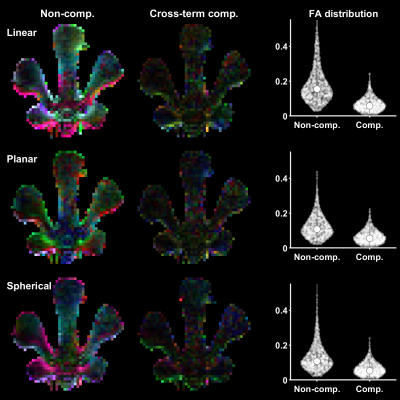Filip Szczepankiewicz1 and Jens Sjölund2
1Clinical Sciences Lund, Lund University, Lund, Sweden, 2Department of Information Technology, Uppsala University, Uppsala, Sweden
1Clinical Sciences Lund, Lund University, Lund, Sweden, 2Department of Information Technology, Uppsala University, Uppsala, Sweden
We propose a novel gradient waveform design for diffusion MRI that removes background gradient cross-terms. We demonstrate that the approach improves accuracy for tensor-valued diffusion encoding.

Figure 3 - A water phantom with a folded surface demonstrates the effect of stationary background gradients. In addition to image distortions, background gradients cause signal variation when waveforms are rotated, causing a positive bias in FA (true value is zero in pure water). Direction encoded color-maps, brightness scaled by FA$$$\in[0.0~0.4]$$$, show prominent coross-term effects for conventional waveforms (high FA), compared to cross-term compensated waveforms, which appear more robust to background gradients (low FA). Violin plots show FA distributions in the slice.

Figure 3 - A water phantom with a folded surface demonstrates the effect of stationary background gradients. In addition to image distortions, background gradients cause signal variation when waveforms are rotated, causing a positive bias in FA (true value is zero in pure water). Direction encoded color-maps, brightness scaled by FA$$$\in[0.0~0.4]$$$, show prominent coross-term effects for conventional waveforms (high FA), compared to cross-term compensated waveforms, which appear more robust to background gradients (low FA). Violin plots show FA distributions in the slice.